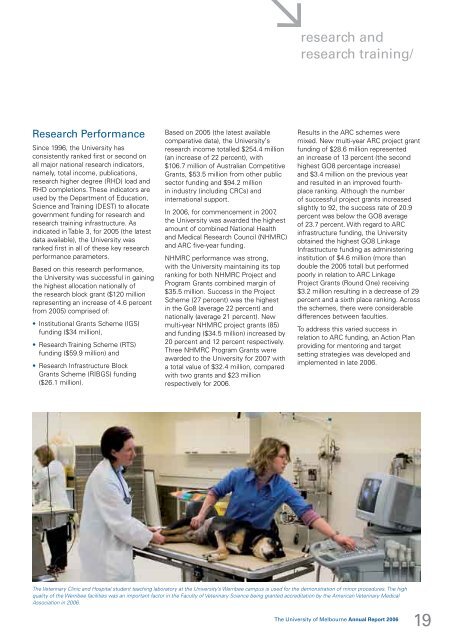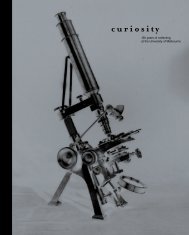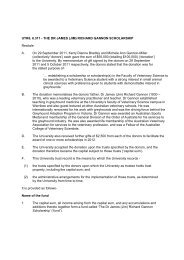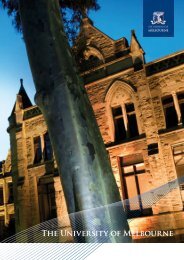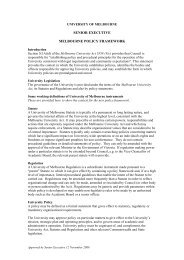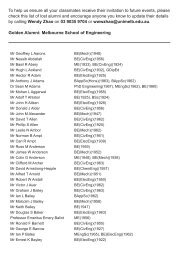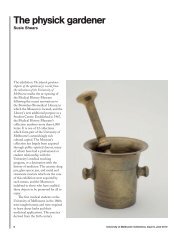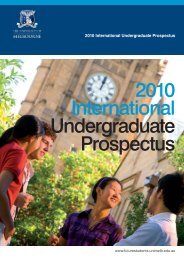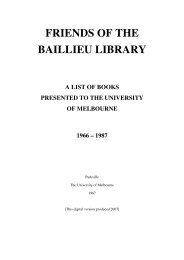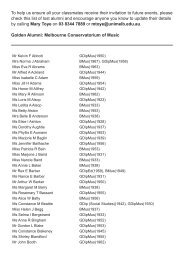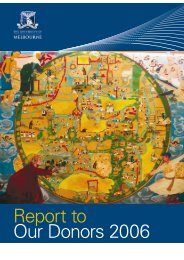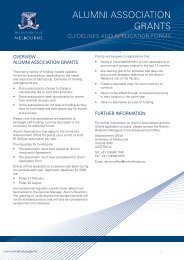annual report/2006 - University of Melbourne
annual report/2006 - University of Melbourne
annual report/2006 - University of Melbourne
Create successful ePaper yourself
Turn your PDF publications into a flip-book with our unique Google optimized e-Paper software.
esearch and<br />
research training/<br />
Research Performance<br />
Since 1996, the <strong>University</strong> has<br />
consistently ranked first or second on<br />
all major national research indicators,<br />
namely, total income, publications,<br />
research higher degree (RHD) load and<br />
RHD completions. These indicators are<br />
used by the Department <strong>of</strong> Education,<br />
Science and Training (DEST) to allocate<br />
government funding for research and<br />
research training infrastructure. As<br />
indicated in Table 3, for 2005 (the latest<br />
data available), the <strong>University</strong> was<br />
ranked first in all <strong>of</strong> these key research<br />
performance parameters.<br />
Based on this research performance,<br />
the <strong>University</strong> was successful in gaining<br />
the highest allocation nationally <strong>of</strong><br />
the research block grant ($120 million<br />
representing an increase <strong>of</strong> 4.6 percent<br />
from 2005) comprised <strong>of</strong>:<br />
• Institutional Grants Scheme (IGS)<br />
funding ($34 million),<br />
• Research Training Scheme (RTS)<br />
funding ($59.9 million) and<br />
• Research Infrastructure Block<br />
Grants Scheme (RIBGS) funding<br />
($26.1 million).<br />
Based on 2005 (the latest available<br />
comparative data), the <strong>University</strong>’s<br />
research income totalled $254.4 million<br />
(an increase <strong>of</strong> 22 percent), with<br />
$106.7 million <strong>of</strong> Australian Competitive<br />
Grants, $53.5 million from other public<br />
sector funding and $94.2 million<br />
in industry (including CRCs) and<br />
international support.<br />
In <strong>2006</strong>, for commencement in 2007,<br />
the <strong>University</strong> was awarded the highest<br />
amount <strong>of</strong> combined National Health<br />
and Medical Research Council (NHMRC)<br />
and ARC five-year funding.<br />
NHMRC performance was strong,<br />
with the <strong>University</strong> maintaining its top<br />
ranking for both NHMRC Project and<br />
Program Grants combined margin <strong>of</strong><br />
$35.5 million. Success in the Project<br />
Scheme (27 percent) was the highest<br />
in the Go8 (average 22 percent) and<br />
nationally (average 21 percent). New<br />
multi-year NHMRC project grants (85)<br />
and funding ($34.5 million) increased by<br />
20 percent and 12 percent respectively.<br />
Three NHMRC Program Grants were<br />
awarded to the <strong>University</strong> for 2007 with<br />
a total value <strong>of</strong> $32.4 million, compared<br />
with two grants and $23 million<br />
respectively for <strong>2006</strong>.<br />
Results in the ARC schemes were<br />
mixed. New multi-year ARC project grant<br />
funding <strong>of</strong> $28.6 million represented<br />
an increase <strong>of</strong> 13 percent (the second<br />
highest GO8 percentage increase)<br />
and $3.4 million on the previous year<br />
and resulted in an improved fourthplace<br />
ranking. Although the number<br />
<strong>of</strong> successful project grants increased<br />
slightly to 92, the success rate <strong>of</strong> 20.9<br />
percent was below the GO8 average<br />
<strong>of</strong> 23.7 percent. With regard to ARC<br />
infrastructure funding, the <strong>University</strong><br />
obtained the highest GO8 Linkage<br />
Infrastructure funding as administering<br />
institution <strong>of</strong> $4.6 million (more than<br />
double the 2005 total) but performed<br />
poorly in relation to ARC Linkage<br />
Project Grants (Round One) receiving<br />
$3.2 million resulting in a decrease <strong>of</strong> 29<br />
percent and a sixth place ranking. Across<br />
the schemes, there were considerable<br />
differences between faculties.<br />
To address this varied success in<br />
relation to ARC funding, an Action Plan<br />
providing for mentoring and target<br />
setting strategies was developed and<br />
implemented in late <strong>2006</strong>.<br />
The Veterinary Clinic and Hospital student teaching laboratory at the <strong>University</strong>’s Werribee campus is used for the demonstration <strong>of</strong> minor procedures. The high<br />
quality <strong>of</strong> the Werribee facilities was an important factor in the Faculty <strong>of</strong> Veterinary Science being granted accreditation by the American Veterinary Medical<br />
Association in <strong>2006</strong>.<br />
The <strong>University</strong> <strong>of</strong> <strong>Melbourne</strong> Annual Report <strong>2006</strong><br />
19


